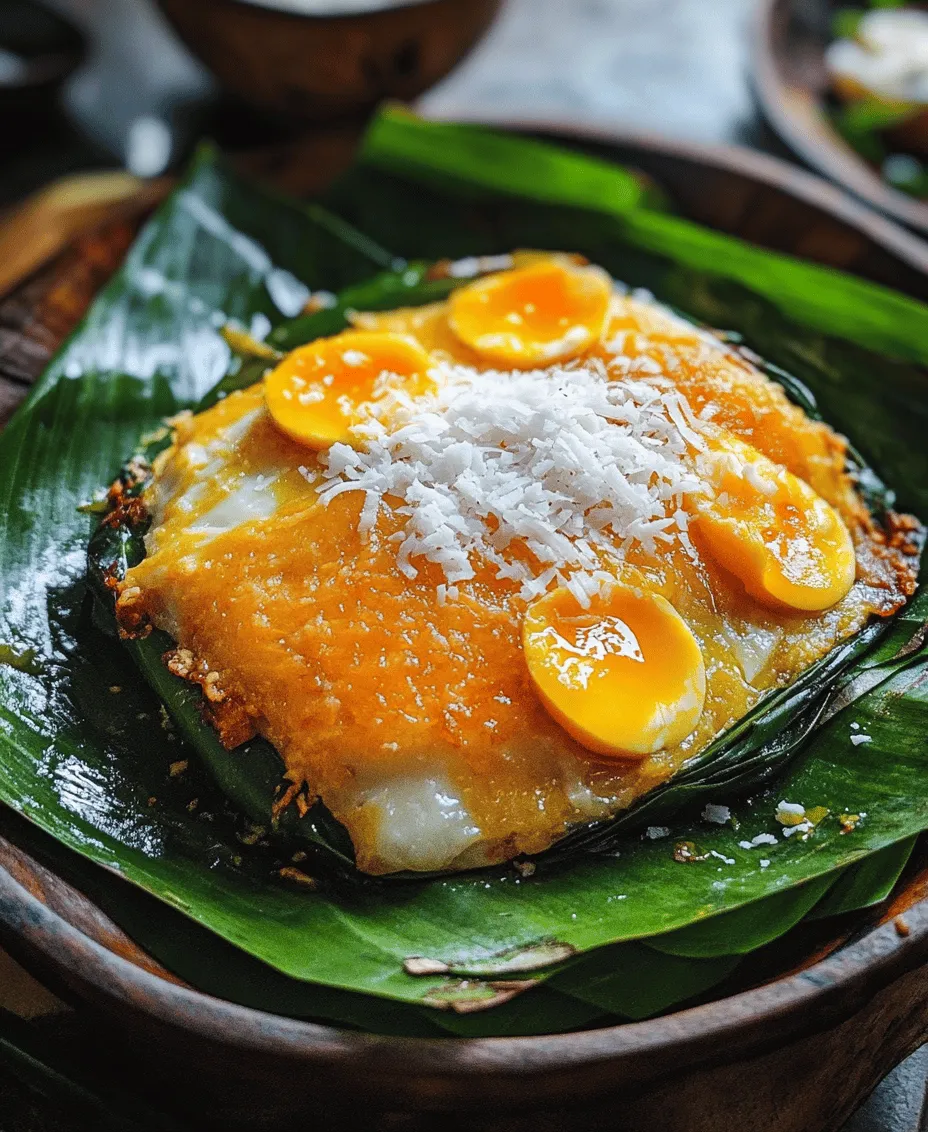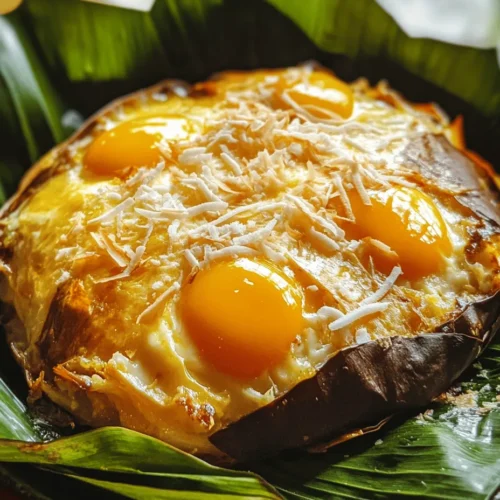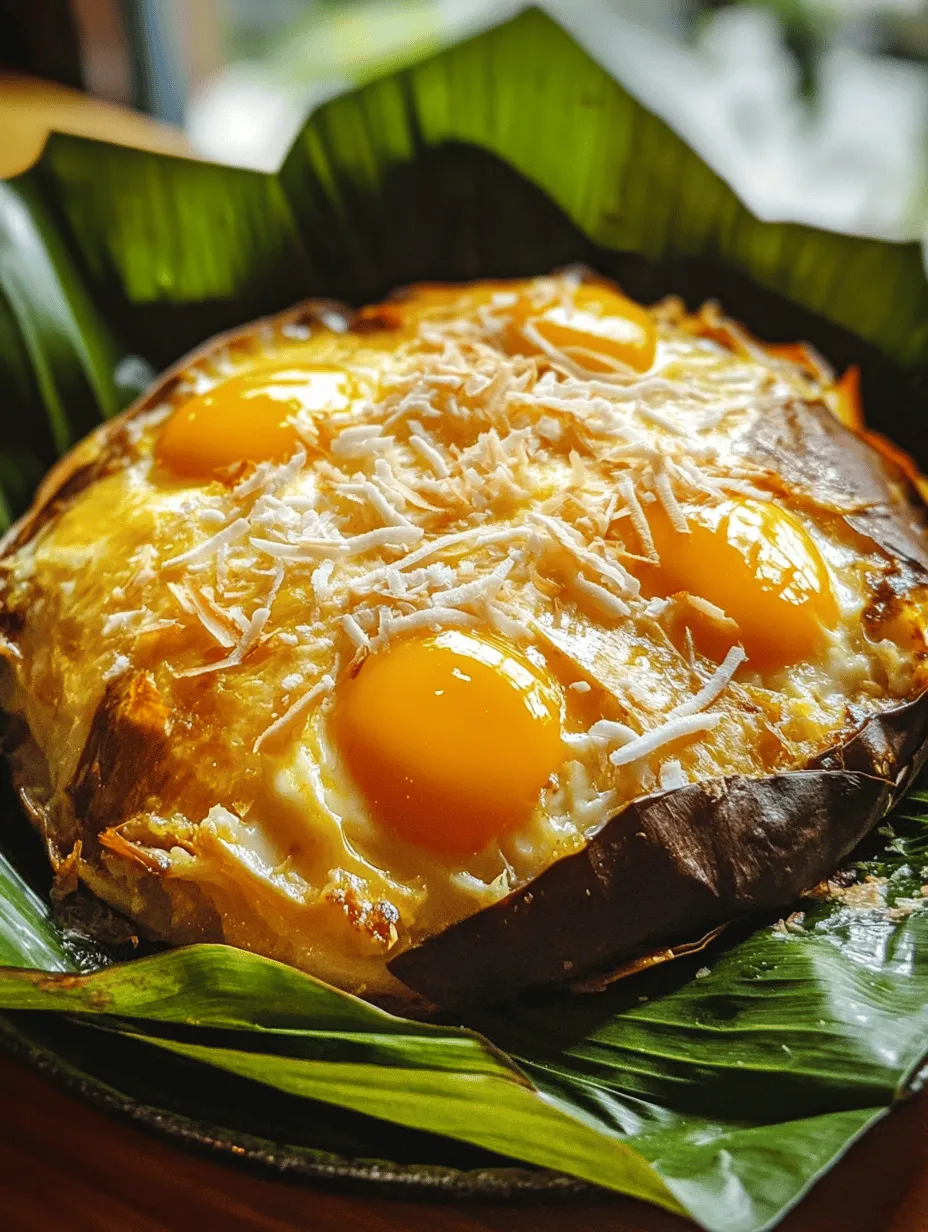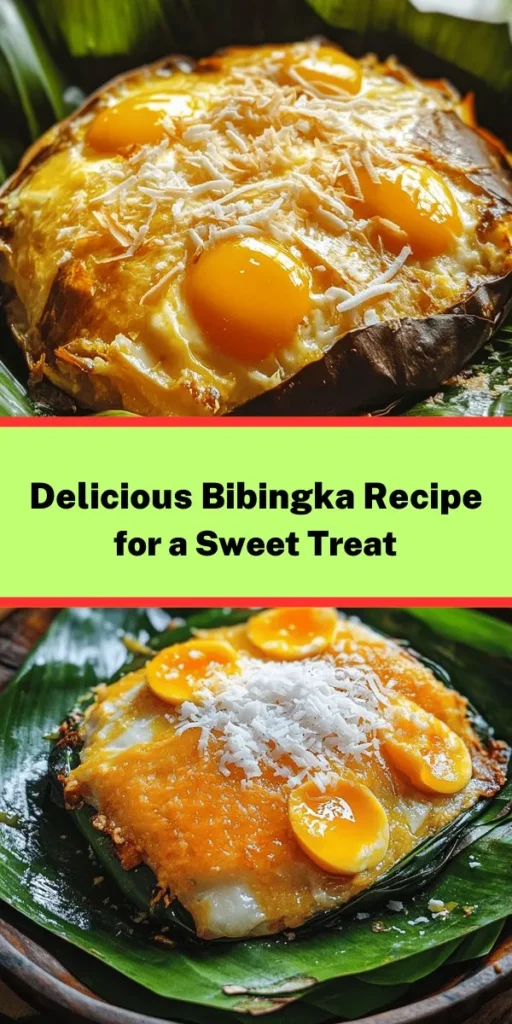Introduction
When it comes to traditional Filipino desserts, few can rival the delightful charm of bibingka, a beloved rice cake that has become a staple in Filipino culture. Originating from the rich culinary heritage of the Philippines, bibingka is more than just a sweet treat; it symbolizes community, family, and celebration. It’s a dish often enjoyed during the festive season, particularly Christmas, where its warm, comforting flavors evoke the spirit of togetherness and joy.
In this article, we will introduce you to a unique twist on the classic bibingka — the Heavenly Bibingka Delight. This version not only honors the traditional roots of bibingka but also elevates it with a blend of textures and flavors that promise to tantalize your taste buds. Whether you are familiar with bibingka or a first-time taster, this recipe will guide you through the process of creating this heavenly treat that will surely become a favorite in your household.
Understanding Bibingka
Historical Background of Bibingka
Bibingka has a rich history that dates back to the pre-colonial era in the Philippines. Traditionally made from ground rice, the cake was baked in clay pots lined with banana leaves, creating a distinctive flavor infused with the aroma of the leaves. This rice cake has evolved over the centuries, influenced by various cultures and local ingredients, resulting in numerous regional variations.
The name “bibingka” itself is derived from the Filipino word “bibi,” which means to bake. In various regions of the Philippines, bibingka is prepared with unique ingredients and methods, showcasing the diverse culinary landscape of the archipelago. From simple preparations to those adorned with toppings like salted eggs, cheese, and even coconut, bibingka remains a beloved comfort food that brings nostalgia and warmth.
The Significance of Bibingka During Festive Seasons
Bibingka holds a special place in Filipino celebrations, particularly during the Christmas season. It is a common sight at the “Simbang Gabi” or the nine-day dawn masses leading up to Christmas, where vendors sell freshly baked bibingka outside churches. The warm, sweet aroma wafting through the air is a comforting reminder of the holiday spirit, drawing families and friends together to enjoy this delightful treat.
In addition to Christmas, bibingka is served during other festive occasions, such as birthdays, family reunions, and local fiestas. Its cultural significance transcends mere enjoyment; bibingka represents tradition, family ties, and the joy of sharing delicious food with loved ones.
Variations of Bibingka Across Different Regions in the Philippines
The beauty of bibingka lies in its adaptability, with each region adding its twist to the classic recipe. In Luzon, you may find the popular “bibingkang galapong,” made with rice flour and coconut milk, offering a soft and tender texture. In the Visayas region, bibingka is often topped with a generous layer of grated cheese, making it a savory-sweet delight. Meanwhile, in Mindanao, you might encounter bibingka made with glutinous rice, resulting in a chewier texture.
These regional variations highlight the creativity and resourcefulness of Filipino cooks, ensuring that bibingka remains a vibrant part of the country’s culinary identity. Regardless of the version, each bite of bibingka encapsulates the spirit of Filipino hospitality and the joy of gathering around the table.
Ingredients Breakdown
To create the Heavenly Bibingka Delight, we will need a selection of high-quality ingredients that contribute to the cake’s unique flavor and texture. Below is a detailed explanation of each ingredient and its role in this delightful recipe.
Rice Flour
At the heart of every bibingka is rice flour, which is crucial for achieving the desired texture. Rice flour gives bibingka its characteristic soft and slightly chewy mouthfeel, setting it apart from other cakes made with wheat flour. It also allows for a gluten-free option, making bibingka accessible to those with gluten sensitivities.
Coconut Milk
Coconut milk is a key ingredient that imparts richness and creaminess to the bibingka. It adds depth of flavor, enhancing the overall taste profile of the cake. The use of coconut milk also reflects the tropical nature of Filipino cuisine, as coconuts are abundant in the Philippines. This ingredient not only complements the rice flour but also contributes to the moistness of the bibingka.
Shredded Coconut
To elevate the coconut flavor further, we incorporate shredded coconut into the batter. It provides added texture and a delightful chewiness that complements the soft base of the bibingka. Shredded coconut also enhances the visual appeal of the dish, giving it a rustic charm that is both inviting and appetizing.
Brown Sugar
Brown sugar plays a significant role in sweetening the bibingka while also contributing to its color and flavor. The molasses content in brown sugar adds a rich, caramel-like taste that balances the cake’s sweetness. It creates a beautiful golden hue as the bibingka bakes, making it visually appealing.
Baking Powder
To ensure our bibingka rises to perfection, baking powder is included in the ingredient list. This leavening agent helps create a light and fluffy texture, making each bite of the cake a delightful experience. Properly incorporating baking powder is essential to achieving the desired lift, so it’s important to measure it accurately.
Salt
While it may seem counterintuitive, a pinch of salt is crucial for balancing the flavors in our bibingka. Salt enhances the sweetness of the cake, allowing all the flavors to shine through. It also helps to round out the overall taste, preventing the bibingka from being overwhelmingly sweet.
Eggs
Eggs are essential for providing structure and moisture to the bibingka. They help bind the ingredients together, ensuring a cohesive batter. The proteins in eggs contribute to the cake’s stability as it bakes, while also adding richness and flavor. Using fresh eggs will yield the best results in terms of taste and texture.
Unsalted Butter
Unsalted butter adds a layer of richness and flavor to the bibingka. It contributes to the cake’s moistness and enhances the overall mouthfeel. Using unsalted butter allows you to control the salt content in the recipe, ensuring a well-balanced flavor profile.
Banana Leaves
Traditionally, bibingka is baked in banana leaves, which not only provide a beautiful presentation but also infuse the cake with a subtle, earthy aroma. Preparing the banana leaves by softening them over an open flame or steaming them allows for easier handling and helps the leaves conform to the baking dish.
Salted Eggs and Cheese
To top off our Heavenly Bibingka Delight, we will be using salted eggs and cheese. Salted eggs add a unique savory contrast to the sweetness of the bibingka, while cheese provides a creamy, rich element. Together, these toppings create a harmonious blend of flavors that elevate the traditional bibingka to a whole new level.
Preparation Steps
Now that we have a thorough understanding of the ingredients, let’s dive into the preparation steps for creating the Heavenly Bibingka Delight. Follow this step-by-step guide to ensure your bibingka turns out perfectly every time.
Preparing Banana Leaves
Before you start mixing the batter, it’s important to prepare the banana leaves. Begin by selecting fresh banana leaves, which can often be found at Asian grocery stores. To make the leaves pliable and easier to work with, briefly heat them over an open flame or steam them for a few minutes. This will soften the leaves, allowing you to mold them into your baking dish without tearing.
Once softened, cut the banana leaves to fit your chosen baking dish. You can use a round or square dish; just ensure that the leaves cover the bottom and the sides completely. This step is crucial, as it not only adds flavor but also prevents the bibingka from sticking to the pan.
Mixing Dry Ingredients
Next, we will move on to mixing the dry ingredients. In a large mixing bowl, combine the rice flour, baking powder, and salt. Whisk the dry ingredients together until they are well-blended and free of lumps. This step is crucial, as it ensures that the leavening agent and salt are evenly distributed throughout the flour, contributing to a light and fluffy bibingka.
Once the dry ingredients are thoroughly mixed, we can proceed to combine them with the wet ingredients to create our batter.
Combining Wet Ingredients
In a separate bowl, combine the coconut milk, melted unsalted butter, eggs, and brown sugar. Whisk together until the mixture is smooth and well-combined. The melted butter should be at room temperature to avoid cooking the eggs when mixed.
Once the wet ingredients are ready, we will gradually add them to the bowl of dry ingredients, mixing gently until everything is just combined. Be careful not to overmix the batter, as this can lead to a dense bibingka. The goal is a smooth, pourable consistency that will rise beautifully in the oven.
Pouring and Baking
After preparing the batter, pour it into the prepared banana leaf-lined baking dish. Spread it evenly with a spatula for uniform baking. If desired, you can sprinkle shredded coconut on top for added texture and flavor before placing the bibingka in the oven.
Preheat your oven to 350°F (175°C) and bake the bibingka for about 30-40 minutes or until the top is golden brown and a toothpick inserted in the center comes out clean. Keep an eye on the baking process, as oven temperatures may vary.
As the bibingka bakes, the delightful aroma will fill your kitchen, creating an anticipation that will make the wait worthwhile. Enjoy the process, as each step brings you closer to enjoying the Heavenly Bibingka Delight!
Adding Toppings
Once the bibingka is almost done baking, you can add the toppings. Carefully remove the bibingka from the oven and layer on the salted eggs and cheese. Return it to the oven for an additional 5-10 minutes, allowing the toppings to melt and meld into the cake.
This final step not only enhances the flavor but also adds an enticing visual appeal to your bibingka, making it a showstopper at any gathering.
Stay tuned for the next part of this article, where we will delve into serving suggestions, storage tips, and answers to common questions about this delightful dessert.

Mixing Wet Ingredients: Achieving a Smooth Mixture for Better Texture
When making Heavenly Bibingka Delight, the first step in mixing your wet ingredients is crucial to achieving that signature smooth texture. Start by gathering your wet ingredients: coconut milk, eggs, melted butter, and sugar. In a large mixing bowl, whisk together the eggs and sugar until the mixture is light and fluffy. This aeration will help create a light, tender bibingka.
Next, gradually add the melted butter while continuing to whisk. The key here is to incorporate the butter fully so that it emulsifies with the eggs and sugar mixture. Once combined, pour in the coconut milk slowly, whisking continuously. This step is important, as coconut milk not only contributes to the flavor but also affects the overall moisture content of your bibingka. Ensure there are no lumps; a smooth mixture will result in a more uniform batter and an even bake.
Combining Mixtures: Tips for Ensuring a Uniform Batter
With your wet mixture ready, it’s time to combine it with the dry ingredients. In a separate bowl, mix your dry components: rice flour, baking powder, and salt. Sifting these ingredients together helps eliminate clumps and aerates the flour, which is essential for the final texture of your bibingka.
Once your dry ingredients are well combined, make a well in the center of the dry mixture. Slowly pour the wet mixture into the well, using a spatula to gently fold the ingredients together. Avoid overmixing, as this can develop gluten and lead to a denser bibingka. Instead, fold until just combined; some lumps are okay. This gentle approach keeps the batter light and airy, ensuring a delightful final product.
Preparing the Baking Dish: Importance of Lining with Banana Leaves
To give your bibingka its traditional flavor and aroma, lining your baking dish with banana leaves is essential. Not only do banana leaves impart a subtle fragrance, but they also prevent the bibingka from sticking to the pan. If you can’t find banana leaves, parchment paper is a suitable substitute, though the flavor may slightly differ.
To prepare the banana leaves, rinse them under warm water to make them pliable, then pat them dry. Cut the leaves to fit your baking dish, leaving enough overhang to fold over the top of the bibingka. Lightly brush the leaves with melted butter or oil to further ensure a non-stick surface. This simple step is vital for achieving the authentic presentation and taste of your bibingka.
Pouring and Baking: Techniques for Optimal Baking Results
Once your baking dish is prepared, it’s time to pour in the batter. Using a ladle or measuring cup, pour the bibingka batter into the lined dish, filling it about three-quarters full to allow room for rising. Preheat your oven to 375°F (190°C) and place the baking dish in the center of the oven.
For optimal baking results, consider placing a baking sheet underneath the dish to catch any drips and promote even heat distribution. Bake the bibingka for approximately 25-30 minutes, or until the edges are golden brown and a toothpick inserted in the center comes out clean. The top should have a slight dome and a beautiful golden hue, signaling that it’s ready to come out of the oven.
Baking Tips for Perfect Bibingka
Achieving the perfect bibingka requires attention to detail. Here are some essential baking tips:
– Ideal Baking Conditions: Ensure your oven is fully preheated before placing the bibingka inside. An uneven temperature can affect the rising and texture of the cake.
– Monitoring Baking Time and Temperature: Keep an eye on your bibingka as it bakes. Ovens can vary, so check for doneness a few minutes before the suggested time.
– Signs of Doneness: Look for a lightly browned top and firm edges. The center should spring back when gently pressed, and a toothpick should come out clean when inserted.
Serving Suggestions: Presentation Tips for an Appealing Dish
Once your Heavenly Bibingka Delight is baked to perfection, it’s time to serve! Allow it to cool in the pan for about 10 minutes before lifting it out using the banana leaves. Carefully peel away the leaves to reveal the beautifully baked bibingka underneath.
For an appealing presentation, slice the bibingka into wedges and serve it on a decorative platter. A light dusting of grated coconut or cheese on top can enhance both the flavor and the visual appeal.
Optional Toppings and Side Dishes to Enhance the Experience
When it comes to toppings, traditional options include a sprinkle of grated cheese or a drizzle of sweetened coconut cream. You may also serve it alongside fresh fruits, such as mango or banana, to add a refreshing contrast. Pairing with a warm cup of coffee or tea can make for a delightful afternoon snack or dessert.
Cultural Significance of Serving Bibingka During Gatherings
Bibingka holds a special place in Filipino culture, often served during festive occasions and family gatherings. Whether it’s Christmas, New Year, or a simple family reunion, the sight of bibingka brings a sense of nostalgia and warmth. Sharing this delicious treat with family and friends fosters a sense of community and celebration.
Nutritional Information
Understanding the nutritional content of your bibingka can help you enjoy it more mindfully. A typical serving provides approximately:
– Calories: 180
– Total Fat: 7g
– Saturated Fat: 4g
– Carbohydrates: 25g
– Protein: 3g
– Fiber: 1g
While bibingka is a delicious treat, it’s wise to enjoy it in moderation, especially if you are watching your caloric intake.
Health Considerations Related to Ingredients Used
The main ingredients in bibingka—rice flour, coconut milk, and eggs—offer a variety of nutrients. Coconut milk provides healthy fats, while rice flour is gluten-free and suitable for those with gluten sensitivities. However, be mindful of the sugar content, which can be adjusted to suit your dietary needs.
Suggestions for Modifications for Dietary Preferences
For those looking for gluten-free options, rice flour is already a perfect choice. If you’re seeking vegan alternatives, you can substitute eggs with flaxseed meal or applesauce and use coconut oil instead of butter. These modifications maintain the essence of the dish while accommodating dietary restrictions.
Cultural Context and Significance
Bibingka is not just a dish; it’s a part of Filipino identity. It represents the rich culinary heritage of the Philippines and is a staple during important celebrations. Many families have their unique recipes, passed down through generations, each carrying precious memories of togetherness and joy.
Sharing bibingka with loved ones creates an opportunity to connect with your roots. It’s a reminder of family gatherings, laughter, and love, reinforcing the importance of sharing meals as a way of strengthening bonds.
Conclusion
Heavenly Bibingka Delight is more than just a delicious treat; it is a heartfelt expression of Filipino culture and tradition. Crafting this delightful dish allows you to connect with the rich heritage of the Philippines while enjoying a delectable dessert that brings joy to any gathering.
Whether you’re making it for a special occasion or simply to satisfy a craving, this recipe invites you to indulge in the flavors and experiences that make bibingka so beloved. We encourage you to try your hand at this recipe, savor the delights of creating something special, and share the joy of bibingka with your family and friends. Embrace the spirit of togetherness and the warmth of tradition with every bite.



